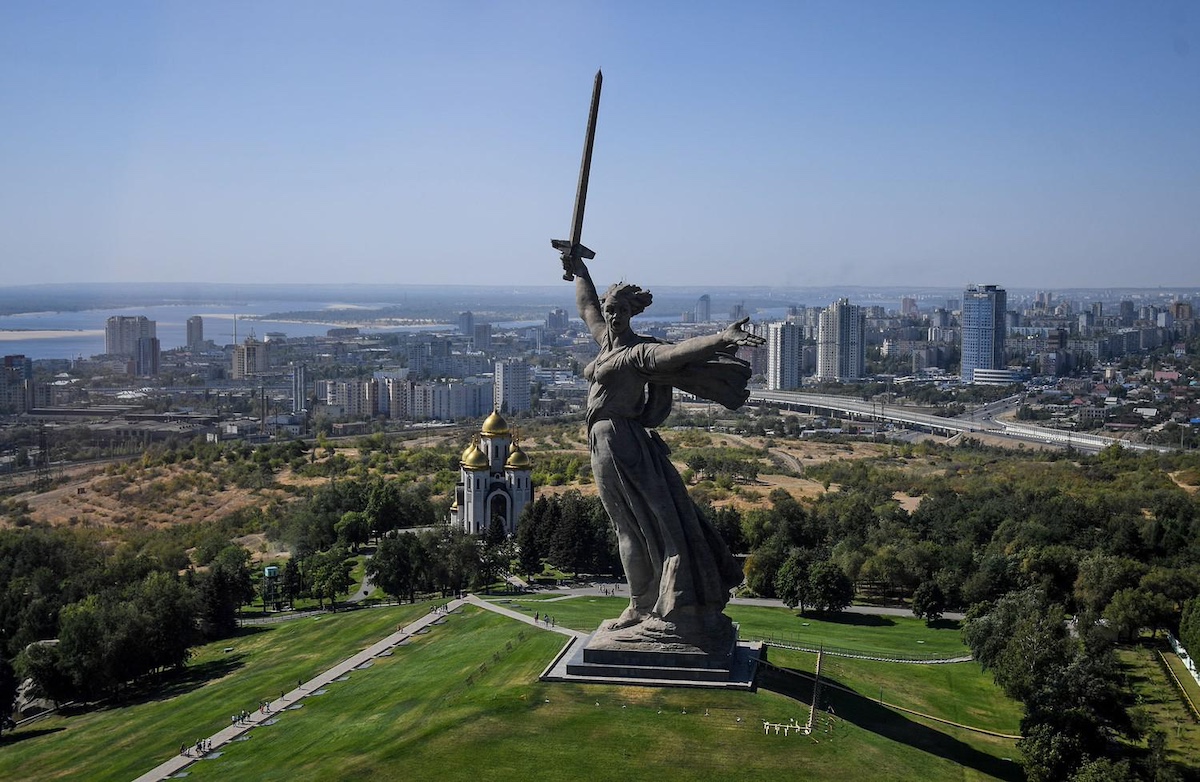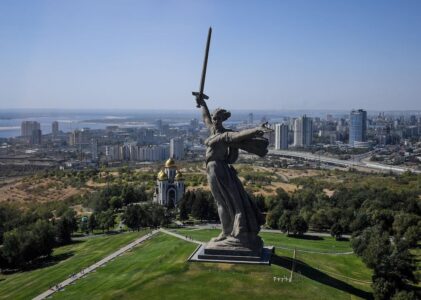Discover the emotional allure of The Motherland Calls monument and the vibrant city of Volgograd. Unearth its rich history, iconic sights, and culinary delights. Plan your journey to this stirring destination with our comprehensive guide.
Description and Popularity
The Motherland Calls, a towering symbol of courage and resilience, dominates the skyline of Volgograd, Russia. This monumental statue, standing at an imposing 85 meters, depicts a defiant woman brandishing a sword, urging her compatriots to defend their homeland during the pivotal Battle of Stalingrad. Crafted by sculptor Yevgeny Vuchetich and engineer Nikolai Nikitin, it stands as a testament to the indomitable spirit of the Soviet people and commemorates the sacrifices made during one of the most brutal conflicts in human history.
The sheer scale and emotive power of The Motherland Calls have made it an iconic landmark, drawing visitors from across the globe to witness its awe-inspiring presence. Perched atop Mamayev Kurgan, a hill overlooking the city, the statue commands attention and evokes a sense of reverence. Its significance extends beyond its physical stature, serving as a poignant reminder of the atrocities of war and the resilience of the human spirit.

Throughout the years, The Motherland Calls has become synonymous with Volgograd, formerly known as Stalingrad, and has played a central role in shaping the city’s identity. It serves as a focal point for remembrance and reflection, inviting visitors to pay homage to the countless lives lost during the Battle of Stalingrad and to honor the enduring legacy of those who fought for freedom and justice.
The popularity of The Motherland Calls is not solely attributed to its monumental size or historical significance; it also embodies a profound sense of emotion and symbolism. Standing beneath its outstretched arm, visitors cannot help but feel a sense of awe and humility in the presence of such a powerful monument. Whether bathed in the golden light of dawn or illuminated against the night sky, The Motherland Calls continues to captivate and inspire all who behold it, serving as a timeless tribute to the human spirit’s triumph over adversity.
Brief History of The Motherland Calls
The history of The Motherland Calls intertwines with the tumultuous events of World War II and the Battle of Stalingrad, a pivotal moment in the conflict between Nazi Germany and the Soviet Union. Following the German invasion of the Soviet Union in 1941, Stalingrad (now Volgograd) became the epicenter of a brutal struggle for control. The city’s strategic location on the banks of the Volga River made it a crucial battleground, with both sides vying for supremacy.
As the battle raged on, Stalingrad endured relentless bombardment and street-to-street fighting, resulting in staggering casualties and widespread destruction. The Soviet forces, under the leadership of Marshal Georgy Zhukov, mounted a fierce defense, refusing to yield to the advancing German army. Amidst the chaos and devastation, the collective will and resilience of the Soviet people emerged as a defining factor in the battle’s outcome.

In 1943, after months of intense combat, the tide of the war began to turn in favor of the Soviet Union. The German forces, besieged and demoralized, faced a decisive defeat as the Red Army launched a massive counteroffensive. The Battle of Stalingrad culminated in a resounding victory for the Soviets, marking a turning point in World War II and shattering the myth of Nazi invincibility.
In the aftermath of the battle, plans were set in motion to commemorate the heroic defense of Stalingrad and honor the sacrifices of those who had perished. The idea for a monumental statue to symbolize the triumph of the Soviet people took shape, with renowned sculptor Yevgeny Vuchetich tasked with bringing the vision to life. Collaborating with engineer Nikolai Nikitin, Vuchetich embarked on the ambitious project of designing and constructing what would become The Motherland Calls.
Construction of the statue began in 1959 and spanned eight years, involving the labor of thousands of workers and engineers. The sheer scale and complexity of the undertaking presented numerous challenges, from the logistics of assembling the colossal figure to the structural integrity of the monument. Despite these obstacles, The Motherland Calls was unveiled on October 15, 1967, in a ceremony attended by dignitaries and veterans alike.
Since its inauguration, The Motherland Calls has stood as a towering symbol of courage and sacrifice, a testament to the indomitable spirit of the Soviet people. Over the decades, it has become an enduring icon of Volgograd, drawing millions of visitors each year to pay homage to history and honor the memory of those who fought and died for freedom. Today, The Motherland Calls serves as a solemn reminder of the price of war and the enduring legacy of those who bravely stood in its path.

When to Visit
The best time to visit The Motherland Calls and Volgograd is during the spring and autumn months (April to June and September to October), when the weather is pleasant and crowds are thinner. Avoid the peak of summer and winter when temperatures can be extreme, impacting your sightseeing experience.
Key Sights
Aside from The Motherland Calls, Volgograd boasts a wealth of attractions that capture its storied past and vibrant present. Visit the Panorama Museum to witness a panoramic painting depicting the Battle of Stalingrad with stunning realism. Explore the ruins of the Mill House, a testament to the city’s resilience amidst destruction. Take a leisurely stroll along the Volga River promenade, offering scenic views and a glimpse into daily life in Volgograd.

Full Itinerary
Day 1: Immersive History
- Morning: Begin your journey at The Motherland Calls, marveling at its grandeur and significance.
- Afternoon: Explore the Panorama Museum and delve into the harrowing tales of the Battle of Stalingrad.
- Evening: Enjoy a leisurely walk along the embankment, soaking in the atmosphere and savoring local cuisine at a nearby restaurant.
Day 2: Cultural Exploration
- Morning: Visit the Volgograd State Historical and Memorial Museum-Preserve to deepen your understanding of the city’s history.
- Afternoon: Discover the architectural marvels of Volgograd, including the Volgograd State New Experimental Theater and the Central Embankment.
- Evening: Indulge in a traditional Russian dinner at a local eatery, accompanied by live music and warm hospitality.
How to Get There and Get Around
Volgograd is accessible by air, rail, and road. Volgograd International Airport serves domestic and international flights, with convenient connections to major cities in Russia and abroad. The city is well-connected by train, with regular services from Moscow, St. Petersburg, and other major hubs. Once in Volgograd, getting around is easy with a network of buses, trams, and trolleybuses, supplemented by taxis and ride-sharing services.
Where to Stay
Volgograd offers a range of accommodation options to suit every budget and preference. For luxury seekers, hotels like the Hilton Garden Inn and the Park Inn by Radisson provide top-notch amenities and central locations. Budget travelers can opt for cozy guesthouses and hostels scattered across the city, offering affordable rates and a chance to mingle with fellow travelers.
Where and What to Eat
Embark on a culinary journey through Volgograd’s diverse gastronomic scene, featuring hearty Russian fare and international delights. Sample traditional dishes like borscht (beet soup), pelmeni (dumplings), and blini (pancakes) at local eateries and street food stalls. For a taste of international cuisine, head to restaurants like La Gondola for Italian fare or Sushi Bum for Japanese delights. Don’t forget to pair your meal with a shot of vodka or a glass of kvass, a refreshing fermented beverage.
Coworking Opportunities
For digital nomads and remote workers, Volgograd offers several coworking spaces equipped with high-speed internet, ergonomic workstations, and networking opportunities. Coworking Volgograd provides a collaborative environment for freelancers and entrepreneurs, with flexible membership plans and convenient locations. Alternatively, cafes like Coffee Like and Coffee Bean offer cozy atmospheres and free Wi-Fi, perfect for a productive work session with a side of caffeine.
The Motherland Calls
In conclusion, The Motherland Calls stands as a beacon of courage and resilience, beckoning visitors to Volgograd to pay homage to history and embrace the spirit of unity. With its compelling attractions, rich history, and warm hospitality, Volgograd invites travelers to embark on an unforgettable journey of exploration and discovery.

